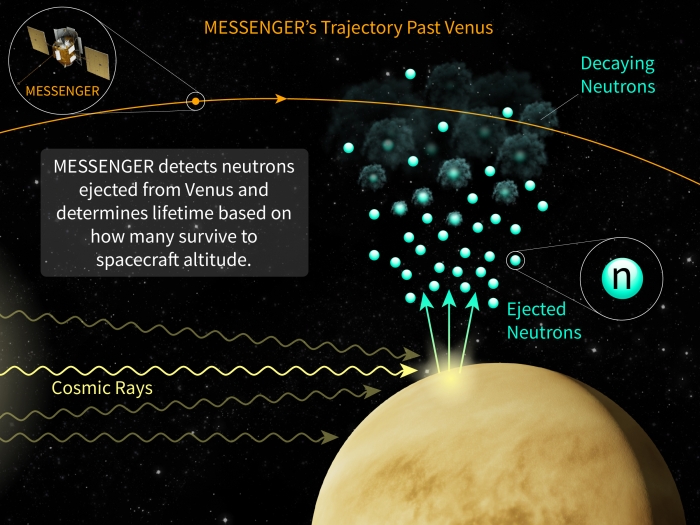For the first time, scientists have measured the lifespan of a neutron in the void of space. The margin of error means we can't narrow it down yet, but once the technique is refined, it could prove to be a game changer.
You see, when safely ensconced in the nucleus of an atom, the subatomic particles we call neutrons have a pretty stable existence. Once ejected from that nucleus, a neutron's lifespan is considerably shorter.
How short? Well, we don't exactly know, since our methods of measuring it return two different results - but scientists would dearly love to resolve it. The new measurement method on neutrons out in space could help figure out the mystery.
In turn, this could help us to better understand how quickly elements formed out of the particle soup that filled the Universe just after the Big Bang, around 13.8 billion years ago.
That process is known as Big Bang nucleosynthesis, and it's thought to have taken place between 10 seconds and 20 minutes after the Big Bang. Knowing how long neutrons can survive on their own will allow cosmologists to cap the upper limit of that timeframe.
"This is the first time anyone has ever measured the neutron lifetime from space," said planetary scientist Jack Wilson of Johns Hopkins University's Applied Physics Laboratory, lead author of the paper describing the new results.
"It proves the feasibility of this method, which could one day be the way to resolve this anomaly."
Since the 1990s, two different classes of experiments have been used here on Earth to try to measure the lifespan of a neutron: "bottle" and "beam".
In the bottle methods, scientists create a trap - mechanical, gravitational, magnetic or a combination - and measure how long the neutrons inside it take to decay.
In the beam methods, scientists fire a beam of neutrons and count the protons and electrons that result as the neutrons decay.
Both of these methods are highly precise, but there's a big problem. The bottle methods, on average, return a decay time of 879.5 seconds, or 14 minutes and 39 seconds, with a 0.5-second error margin. The beam method comes back with an average of 888 seconds, or 14 minutes and 48 seconds, with a 2-second error margin.
That 9-second difference between the two averages might not seem like a lot, but when trying to narrow down the lifespan of a neutron, it's huge - especially since the error margins don't even come close to touching it. And this is where space comes in.
When the cosmic rays that are constantly streaming through space collide with atoms on a planet's surface or in its atmosphere, some neutrons are knocked loose, and make their way into space until they decay. Theoretically, at higher altitudes, there should be fewer neutrons - but you need the right instrument at the right altitude in order to take measurements.
Between 2011 and 2015, NASA's MErcury Surface, Space ENvironment, GEochemistry, and Ranging (MESSENGER) spacecraft orbited Mercury, but its route there was a complicated one that involved two Venus flybys and three Mercury flybys.
 (Johns Hopkins APL)
(Johns Hopkins APL)
As it zoomed past Venus, MESSENGER's neutron spectrometer collected data on the neutrons streaming out of the planet at a speed of a few kilometres per second.
At a minimum altitude of 339 kilometres (210 miles), MESSENGER was close to the maximum distance those neutrons could have travelled before decaying. Similar measurements were taken during the Mercury flybys, at a minimum altitude of 205 kilometres (127 miles).
"It's like a large bottle experiment, but instead of using walls and magnetic fields, we use Venus' gravity to confine neutrons for times comparable to their lifetime," Wilson said.
To calculate the lifespan of the neutrons, the team modelled how many neutrons they should detect at the Venusian flyby altitudes for a range of lifespans, between 10 and 17 minutes. According to this modelling, a lifespan of around 780 seconds - 13 minutes - was the best fit.
But this result also came with an error margin of 60 seconds either way, which means it's still within range of the bottle and beam measurements.
So, the neutron lifespan isn't entirely solved just yet. In fact, MESSENGER wasn't trying to collect data for this sort of calculation. The ability to do it at all using data from the probe - even with a large margin of error - is impressive.
And the success of the team's techniques shows that there's value in trying to refine the measurement with a dedicated mission. Various space agencies are currently considering Venus probes; and the team is working on figuring out an instrument that could take the fine measurements they need.
"We ultimately want to design and build a spacecraft instrument that can make a high-precision measurement of the neutron lifetime," Wilson said.
The research has been published in Physical Review Research.
#Space | https://sciencespies.com/space/for-the-first-time-the-lifetime-of-a-neutron-has-been-measured-in-space/
No comments:
Post a Comment